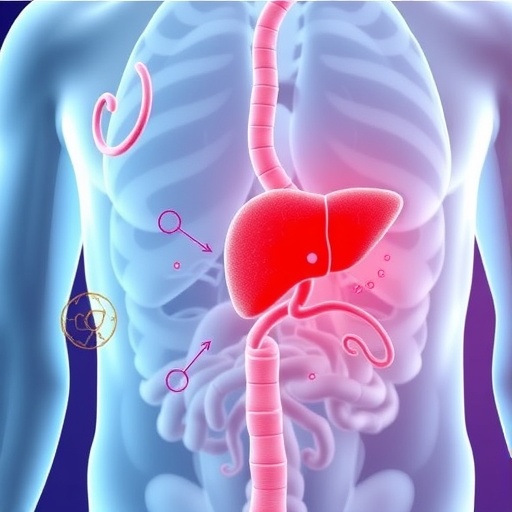Recent advancements in the understanding of metabolic dysfunction-associated fatty liver disease (MAFLD) have revealed intricate connections with serum uric acid levels. A groundbreaking systematic review and meta-analysis by Zhou et al. has delved into these associations, bringing to light the potential implications for diagnosis and management of this increasingly prevalent condition. The review synthesizes findings from a multitude of studies, drawing attention to the complex interplay between uric acid metabolism and liver health, shedding new insights into the pathophysiology of MAFLD.
Metabolic dysfunction-associated fatty liver disease has emerged as a critical public health concern, affecting millions worldwide due to rising obesity rates and sedentary lifestyles. MAFLD is characterized by excessive fat accumulation in the liver, which can progress to inflammation, fibrosis, and ultimately cirrhosis or liver failure if not appropriately managed. Understanding the risk factors associated with MAFLD is essential for developing effective prevention and treatment strategies, making the correlation with serum uric acid a key area of interest for researchers.
Uric acid, a byproduct of purine metabolism, has historically been implicated in conditions such as gout and kidney disease. Recent studies, however, have begun to explore its role beyond these traditional confines, particularly in relation to metabolic syndromes. Elevated levels of uric acid have been linked to insulin resistance and increased visceral fat, both of which are significant contributors to the development of MAFLD. This has prompted scientists to investigate whether uric acid could serve as a biomarker for early intervention in liver disease.
Zhou et al.’s meta-analysis is particularly noteworthy because it represents an exhaustive examination of existing literature, encompassing studies that investigate both direct correlations and the mechanisms underlying these relationships. The authors meticulously analyzed data from various populations, highlighting the importance of diet, exercise, and genetic predispositions in influencing both uric acid levels and liver health. This comprehensive approach underscores the multifactorial nature of MAFLD, suggesting that targeting uric acid levels might yield beneficial effects on liver function.
The review highlighted several pivotal findings, including a consistent association between elevated serum uric acid levels and an increased risk of MAFLD. This correlation remains robust even when adjusting for confounding variables such as body mass index, age, and sex. Furthermore, the authors discussed the potential for uric acid to act as a mediator in the development of liver steatosis, proposing that high uric acid levels may exacerbate insulin resistance, thereby promoting fat accumulation in hepatic tissues.
In examining the role of dietary factors, the authors noted that diets high in fructose and purine-rich foods are significant contributors to elevated uric acid levels. This raises important questions about the broader implications of dietary habits in the management of fatty liver disease. Public health initiatives aimed at reducing consumption of high-fructose corn syrup and promoting balanced nutrition could be vital in addressing the rising prevalence of MAFLD, as well as systemic uric acid levels.
Moreover, the meta-analysis incorporated studies focusing on the effects of pharmacological interventions on liver health and uric acid levels. Notably, medications such as allopurinol, traditionally used to lower uric acid in gout patients, are now being explored for their potential to improve liver outcomes in individuals with elevated uric acid and MAFLD. These findings suggest a promising area for future research and might pave the way for novel treatment paradigms.
One of the most significant contributions of Zhou et al. is the proposal of actionable strategies for clinical practice and future research. They advocate for the integration of serum uric acid measurement in routine evaluations of patients at risk for MAFLD. Identifying patients with elevated uric acid could enable healthcare providers to implement lifestyle modifications and pharmacotherapy aimed at reducing both uric acid levels and liver fat accumulation concurrently.
The implications of this work extend beyond individual patient care; they suggest a paradigm shift in how clinicians approach metabolic liver diseases. By emphasizing the link between uric acid and liver health, healthcare systems may begin to reframe their strategies to encompass broader metabolic health, potentially resulting in improved outcomes not just for MAFLD, but also for associated comorbidities such as cardiovascular disease and diabetes.
In summary, the systematic review and meta-analysis conducted by Zhou et al. underscores the critical relationship between serum uric acid and metabolic dysfunction-associated fatty liver disease. Their findings suggest that monitoring and managing uric acid levels may represent an important strategy in combating MAFLD. As research progresses, the implementation of such findings could reshape clinical practices, paving the way for enhanced prevention and treatment protocols in the context of this pressing public health challenge.
The urgency of addressing MAFLD cannot be overstated, particularly in the context of a global rise in obesity and related metabolic syndromes. Future investigations into the implications of uric acid modulation could revolutionize our understanding and management of fatty liver disease. The insights provided by Zhou et al. imply that managing uric acid levels could be a pivotal step in improving liver health and overall metabolic wellness in the population.
Continuous research in this area is essential, as it holds promise for illuminating further connections between metabolic pathways and liver function. As we explore the nuances of how uric acid interacts with liver physiology, we must remain cognizant of the broader lifestyle factors at play. This holistic approach will be vital for tackling the epidemic of MAFLD effectively, enhancing patient outcomes through informed dietary choices, pharmacological interventions, and lifestyle changes.
In the face of rising rates of MAFLD worldwide, it is imperative for researchers, healthcare providers, and policymakers to collaborate in order to translate these findings into practice. The integration of evidence-based insights into public health strategies will be crucial for curbing the progression of liver disease and related health complications, ultimately contributing to a healthier society overall.
Subject of Research: The correlation between serum uric acid and metabolic dysfunction-associated fatty liver disease.
Article Title: The Correlation Between Serum Uric Acid and Metabolic Dysfunction-Associated Fatty Liver Disease: An Updated Systematic Review and Meta-Analysis.
Article References:
Zhou, S., Ma, X., Tian, F. et al. The Correlation Between Serum Uric Acid and Metabolic Dysfunction-Associated Fatty Liver Disease: An Updated Systematic Review and Meta-Analysis.
J GEN INTERN MED (2025). https://doi.org/10.1007/s11606-025-09904-w
Image Credits: AI Generated
DOI:
Keywords: Metabolic dysfunction-associated fatty liver disease, serum uric acid, systematic review, meta-analysis, liver health, obesity, insulin resistance, dietary factors.
Tags: connection between purine metabolism and liver healthfatty liver disease public health concernimplications of uric acid in liver managementMAFLD and uric acid levelsMetabolic dysfunction-associated fatty liver diseasepathophysiology of fatty liver diseaseprevention strategies for MAFLDrising obesity rates and liver diseaserisk factors for fatty liver diseaseserum uric acid and liver healthuric acid and fatty liver diseaseuric acid research in metabolic syndromes





